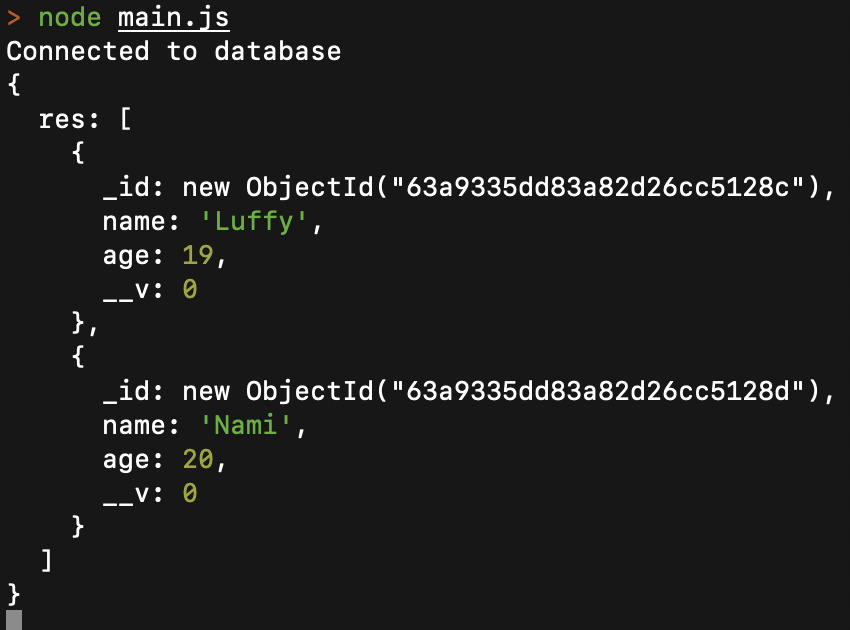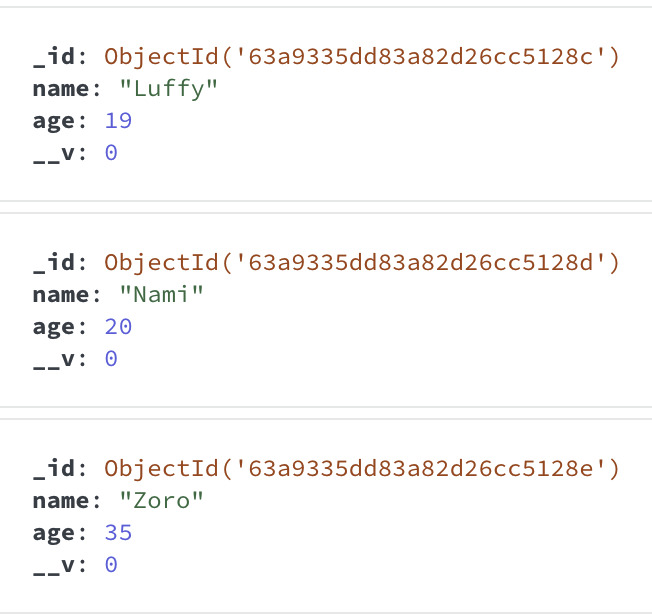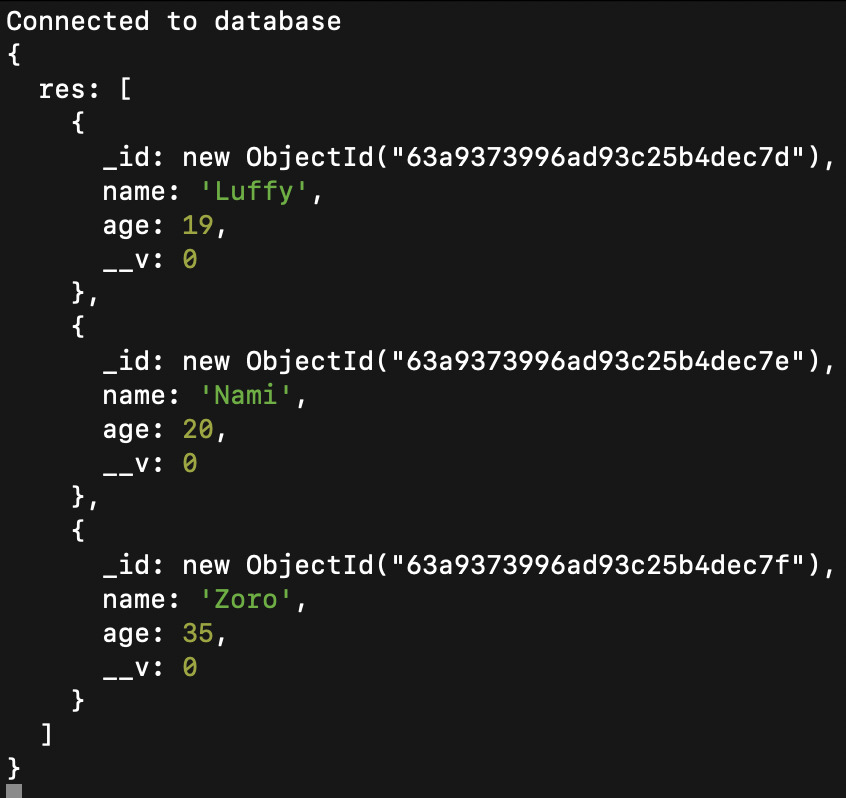Mongoose API 的 Aggregate API.prototype.limit() 函数用于限制传递到聚合器管道中下一个阶段的文档数量。
用法:
Aggregate.prototype.limit()
参数:它接受单个参数,如下所述:
- num: 它是一个数字,定义传递到下一阶段的最大文档数。
返回类型:它返回聚合文档作为响应。
设置 Node.js Mongoose 模块:
步骤 1:使用以下命令创建 Node.js 应用程序:
npm init
步骤 2:创建 NodeJS 应用程序后,使用以下命令安装所需的模块:
npm install mongoose
下面的示例将演示 Mongoose Aggregate API.prototype.limit() 方法。
示例 1:在此示例中,我们将使用此方法从响应中返回前 2 个文档。
文件名:main.js
Javascript
const mongoose = require('mongoose')
// Database connection
mongoose.connect('mongodb://localhost:27017/query-helpers',
{
dbName: 'event_db',
useNewUrlParser: true,
useUnifiedTopology: true
}, err => err ? console.log(err)
: console.log('Connected to database'));
const personSchema = new mongoose.Schema({
name: {
type: String,
},
age: {
type: Number,
}
});
const personsArray = [
{
name: 'Luffy',
age: 19
},
{
name: 'Nami',
age: 20
},
{
name: 'Zoro',
age: 35
}
]
const Person = mongoose.model('Person', personSchema);
(async () => {
await Person.insertMany(personsArray);
const res = await Person.aggregate().limit(2);
console.log({ res });
})()运行应用程序的步骤:从项目的根目录使用以下命令运行应用程序:
node main.js
输出:

使用 MongoDB Compass 的数据库的 GUI 表示:

示例 2:在此示例中,我们将使用此方法来限制响应中的前 10 个文档。
文件名:main.js
Javascript
const mongoose = require('mongoose')
// Database connection
mongoose.connect('mongodb://localhost:27017/query-helpers',
{
dbName: 'event_db',
useNewUrlParser: true,
useUnifiedTopology: true
}, err => err ? console.log(err)
: console.log('Connected to database'));
const personSchema = new mongoose.Schema({
name: {
type: String,
},
age: {
type: Number,
}
});
const personsArray = [
{
name: 'Luffy',
age: 19
},
{
name: 'Nami',
age: 20
},
{
name: 'Zoro',
age: 35
}
]
const Person = mongoose.model('Person', personSchema);
(async () => {
await Person.insertMany(personsArray);
const res = await Person.aggregate().limit(10);
console.log({ res });
})()运行应用程序的步骤:从项目的根目录使用以下命令运行应用程序:
node main.js
输出:

使用 MongoDB 指南针的数据库的 GUI 表示:

参考: https://mongoosejs.com/docs/api/aggregate.html#aggregate_Aggregate-limit
相关用法
- Mongoose Aggregate.prototype.lookup()用法及代码示例
- Mongoose Aggregate.prototype.catch()用法及代码示例
- Mongoose Aggregate.prototype.exec()用法及代码示例
- Mongoose Aggregate.prototype.model()用法及代码示例
- Mongoose Aggregate.prototype.skip()用法及代码示例
- Mongoose Aggregate.prototype.then()用法及代码示例
- Mongoose Aggregate.prototype.append()用法及代码示例
- Mongoose Aggregate.prototype.sortByCount()用法及代码示例
- Mongoose Aggregate.prototype.project()用法及代码示例
- Mongoose Aggregate.prototype.pipeline()用法及代码示例
- Mongoose Aggregate.prototype.match()用法及代码示例
- Mongoose Aggregate.prototype.cursor()用法及代码示例
- Mongoose Aggregate.prototype.sort()用法及代码示例
- Mongoose Aggregate.prototype.addFields()用法及代码示例
- Mongoose Aggregate prototype.unionWith()用法及代码示例
- Mongoose Aggregate prototype.sample()用法及代码示例
- Mongoose Aggregate prototype.unwind()用法及代码示例
- Mongoose countDocuments()用法及代码示例
- Mongoose deleteMany()用法及代码示例
- Mongoose deleteOne()用法及代码示例
- Mongoose estimatedDocumentCount()用法及代码示例
- Mongoose exists()用法及代码示例
- Mongoose find()用法及代码示例
- Mongoose findById()用法及代码示例
- Mongoose findByIdAndDelete()用法及代码示例
注:本文由纯净天空筛选整理自dishebhbhayana大神的英文原创作品 Mongoose Aggregate.prototype.limit() API。非经特殊声明,原始代码版权归原作者所有,本译文未经允许或授权,请勿转载或复制。
